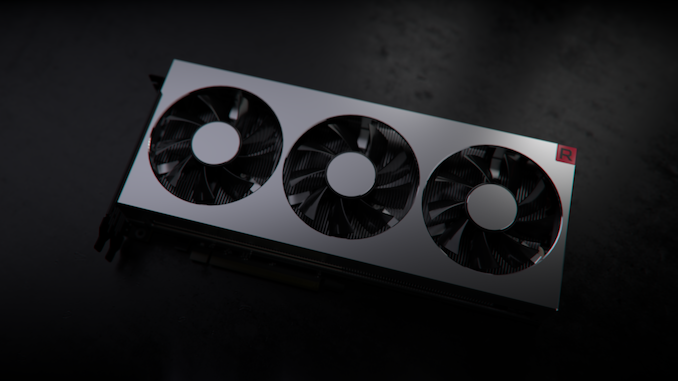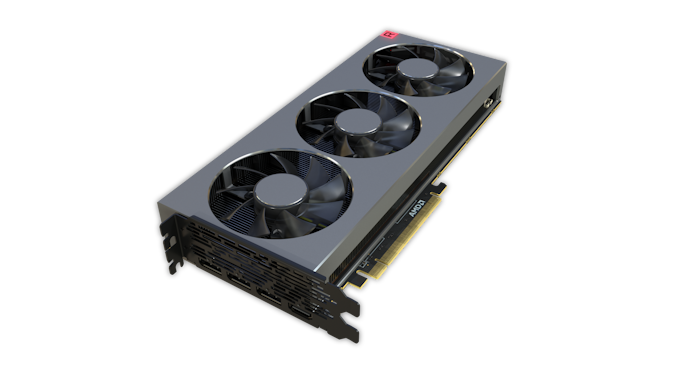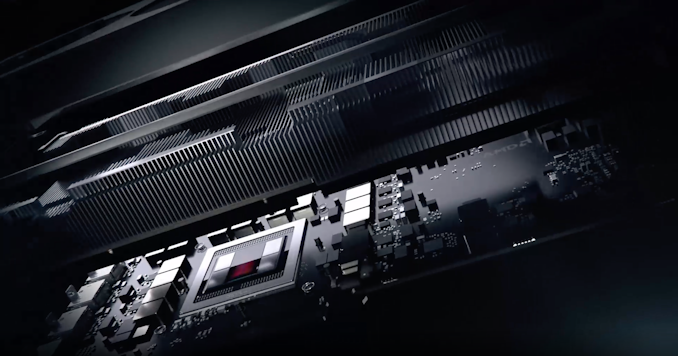The AMD Radeon VII Review: An Unexpected Shot At The High-End
by Nate Oh on February 7, 2019 9:00 AM ESTMeet The Radeon VII
First things first is the design and build, and for the AMD Radeon VII, we've already noticed the biggest change: an open air cooler. Keeping the sleek brushed metal look of the previous RX Vega 64 Limited Edition and Liquid variants, they've forgone the blower for a triple axial fan setup, the standard custom AIB configuration for high-end cards.
While NVIDIA's GeForce RTX series went this way with open-air dual-fan coolers, AMD is no stranger to changing things up themselves. Aside from the RX Vega 64 Liquid, the R9 Fury X's AIO CLC was also quite impressive for a reference design. But as we mentioned with the Founders Edition cards, moving away from blowers for open-air means adopting a cooling configuration that can no longer guarantee complete self-cooling. That is, cooling effectiveness won't be independent of chassis airflow, or lack thereof. This is usually an issue for large OEMs that configure machines assuming blower-style cards, but this is less the case for the highest-end cards, which for pre-builts tend to come from boutique system integrators.
The move to open-air does benefit higher TDP, and at 300W TBP the Radeon VII is indeed one for higher power consumption. While 5W more than the RX Vega 64, there's presumably more localized heat with two more HBM2 stacks, plus the fact that the same amount of power is being consumed but on a smaller die area. And at 300W TBP, this would mean that all power-savings from the smaller process were re-invested into performance. If higher clockspeeds are where the Radeon VII is bringing the majority of its speedup over RX Vega 64, then there would be little alternative to abandoning the blower.
Returning to the Radeon VII build, then, the card naturally has dual 8-pin PCIe connectors, but lacks the BIOS switch of the RX Vega cards that toggled a lower-power BIOS. And with the customary LEDs, the 'Radeon' on the side lights up, as does the 'R' cube in the corner.
In terms of display outputs, there are no surprises here with 3x DisplayPort and 1x HDMI.
A few teardowns of the card elsewhere revealed a vapor chamber configuration with a thermal pad for the TIM, rather than the usual paste. While lower-performing in terms of heat transfer, we know that the RX Vega cards ended up having molded and unmolded package variants, requiring specific instructions to manufacturers on the matter. So this might be a way to head off potential ASIC height difference issues.














289 Comments
View All Comments
29a - Thursday, February 7, 2019 - link
As usual in these garbage articles the prices given are nowhere near reality. The Vega 64 is $100 cheaper than what is listed.RSAUser - Thursday, February 7, 2019 - link
Anandtech doesn't ever seem to update reviews or prices.They'll compare a device from their history even if there have been months of driver updates that fixed performance issues, so they'll be using non-current info and everyone will assume it's current.
Ryan Smith - Thursday, February 7, 2019 - link
"Anandtech doesn't ever seem to update reviews or prices."On the contrary, quite a bit was updated for this review. Though as driver performance has been rather stable as of late, performance hasn't exactly gone anywhere for most cards on most games.
If you see anything that seems wrong, please let us know. But we go out of our way to try to avoid using any card/driver combinations that result in performance issues.
Korguz - Thursday, February 7, 2019 - link
29aif you think AT does nothing but garbage articles.. then, lets see YOU do better...
as for prices.. meh.. thats something hard to account for as there are things called exchange rates, and other variables that no one can predict.....
Phil85 - Thursday, February 7, 2019 - link
So when will prices of GPU's decrease? Is this the new normal?eva02langley - Thursday, February 7, 2019 - link
Navi should bring value back to mid-range.It is still a nice card for professional/compute/rendering. But for gaming, the price is maybe 50$ too expensive, and AMD really needs to get some better quality fans.
TEAMSWITCHER - Thursday, February 7, 2019 - link
If Navi is missing next generation features like ray tracing and tensor cores, there will be ZERO value to it.eva02langley - Thursday, February 7, 2019 - link
AHAHAHAHA... Ray Tracing... you know the real problem of Ray Tracing? It was never on the table until Jensen brainwashed shill that it was important. by defending it, you obviously prove that you have no critical judgement.By the way, the problem with RT/DLSS is that it will never be implemented because AMD owns consoles, and that devs develop on consoles. There is no monetary benefit to implement gimmick proprietary gameworks features for 1% of the PC user base, unless if Nvidia is paying you to do so.
It will never be a thing for the upcoming console generation. See you in 7 years, where it might be remotely relevant to the industry. As of now, unless you are rendering a CGI movie, it is worthless.
Dribble - Thursday, February 7, 2019 - link
Both the next gen consoles are going to have ray tracing. Microsoft - who wrote and own the spec for the DX12 ray tracing extension currently used by PC's and hence a strong backer of ray tracing - will make one of them.eva02langley - Thursday, February 7, 2019 - link
Not going to happen because RTX is proprietary, it is a closed environment, and require hardware acceleration that AMD is not going to pursue in the short time. Nvidia shoot themselves in the foot by pushing it. Open source is the only way a new standard can be adopted. The whole G-synch fiasco should have been enough to prove it.Hardware could run it still, but the impact on performances is just to important. At that point, developers like Sony have incredible talent in creating new effect that look way more realistic.
Just looking at The Last of Us Part 2 is a good example.